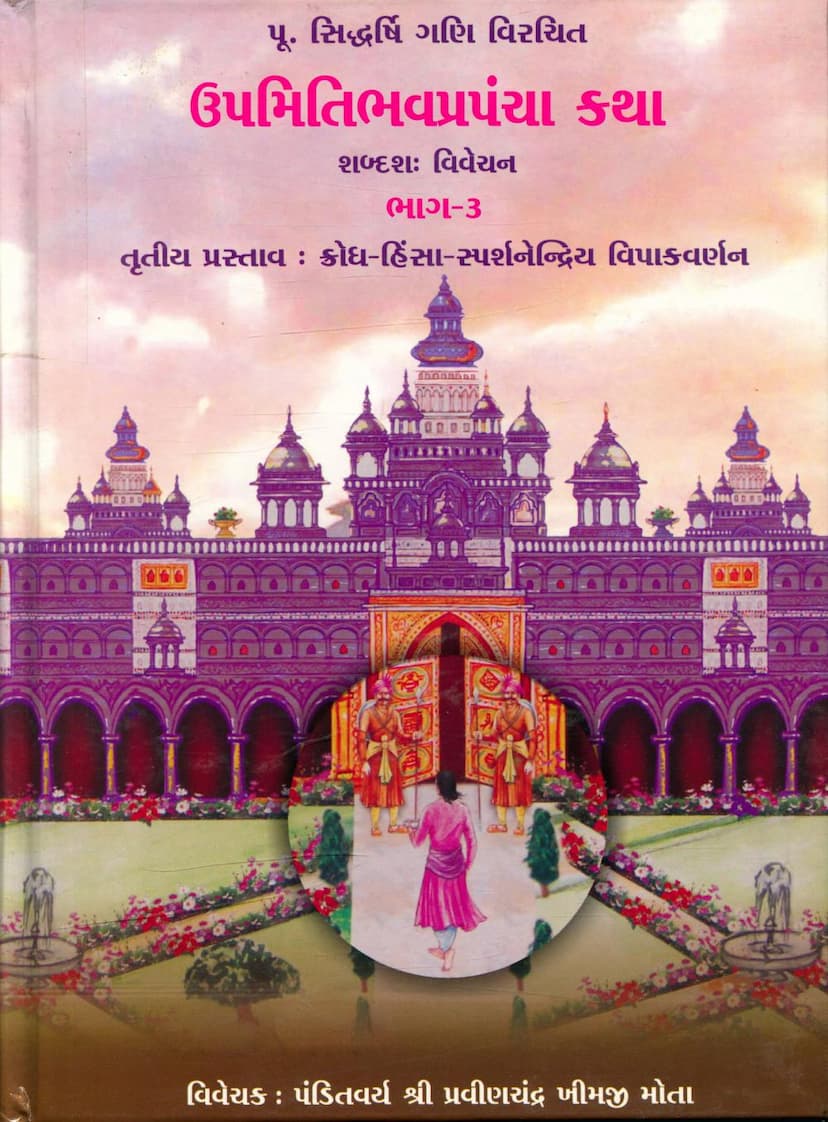Upmiti Bhav Prapancha Katha Part 03
Added to library: September 2, 2025

Summary
Upamiti Bhavaprapancha Katha, Part 03: A Comprehensive Summary
This is a detailed summary of the third part of "Upamiti Bhavaprapancha Katha" (The Analogy of the Cycle of Existence), authored by Pravin K. Mota and published by Gitarth Ganga. This volume focuses on the third treatise (Tritiya Prastav) and describes the consequences of anger, violence, and the sense of touch, as interpreted and elaborated by Panditvar Shri Pravinchandra Khimji Mota.
Overall Context and Authorship:
- Original Work: The text is a commentary ("Shabdshaha Vivechan") on the classic Jain work "Upamiti Bhavaprapancha Katha" by Acharya Shri Siddharshi Gani.
- Commentator: Panditvar Shri Pravinchandra Khimji Mota is the primary commentator.
- Inspiration and Blessings: The work draws inspiration and blessings from Param Pujya Acharyadev Shrimad Vijay Ramchandrasurishwarji Maharajashri, his disciple Param Pujya Muni P. Shrimad Mohjit Vijayji Maharajashri, and the current acharya, Param Pujya Acharya Bhagwant Shrimad Vijay Yugbhushan Surishwarji Maharajashri.
- Compilation: Rakhiben Ramanlal Shah is credited with the compilation.
- Publisher: Gitarth Ganga Trust, located at "Shrutdevta Bhavan," Paldi, Ahmedabad.
Key Themes and Content of Part 03:
This volume, specifically focusing on anger (Krodh), violence (Himsa), and the sense of touch (Sparshanendriya) and their consequences (Vipaka Varnan), delves into the narrative through a detailed commentary. The core of this part of the text is an allegorical story illustrating the pitfalls of attachment to sensory pleasures and the destructive nature of negative emotions.
Narrative Structure and Characters (as revealed through the summary):
The text follows the journey of Nandivardhan, who is depicted as the soul (Sansari Jiv) in various stages of life. His experiences highlight the consequences of:
- Internal and External Circumstances: Nandivardhan's life is influenced by both his internal emotional state and external events.
- The Influence of Negative Qualities Personified:
- Vaishvanar: A character representing the internal influence of wrath, anger, and aggression. Vaishvanar is shown as a constant companion and advisor to Nandivardhan, subtly leading him towards negative actions.
- Hiṁsā: The personification of violence, who becomes Nandivardhan's wife, further entangling him in detrimental actions.
- The Kingdom of Saudhars or Rajs-chitta: The setting often reflects the internal state of the characters.
- The Counteracting Influence of Virtues:
- Manishi: Represents wisdom and insight, often trying to guide Nandivardhan away from his destructive path.
- Subuddhi: Represents good intellect and guidance.
- Chaitanya: Represents consciousness or awareness.
- Daya: The personification of compassion, who plays a crucial role in the path towards liberation.
- Kshama (Forgiveness): Portrayed as a powerful daughter of Shubhasundari (representing good results) and Shubhasundari herself, symbolizing the overcoming of anger and negative emotions.
- The Role of External Guidance: The narrative features characters like Vidur (a wise minister) and Kalanva and Vichaksana (celestial beings or spiritual guides) who offer advice and intervention.
- The Conflict and Resolution: The story often revolves around Nandivardhan's struggle against his negative tendencies (personified by Vaishvanar, Himsa, and the allure of sensory pleasures), his entanglement in worldly affairs, and the eventual attempt to guide him towards the path of righteousness and liberation.
Key Plot Points and Teachings:
- The Birth of Nandivardhan and Vaishvanar: The story begins with Nandivardhan's birth, paralleled by the birth of Vaishvanar, symbolizing the manifestation of inner wrath and pride alongside the soul's journey.
- The Influence of Bad Company: Vaishvanar's constant presence and manipulation highlight the destructive influence of negative qualities and bad company (papamitra).
- Sensory Indulgences and Their Consequences: The narrative details Nandivardhan's susceptibility to sensory pleasures, particularly touch (sparsha), which are depicted as ultimately leading to misery and a deviation from the path of righteousness.
- The Role of Wisdom and Guidance: Manishi and other wise figures attempt to guide Nandivardhan, but his attachment to negative influences hinders his progress.
- The Power of Virtue: The text emphasizes the importance of virtues like forgiveness (Kshama), compassion (Daya), and wisdom (Viveka) as counterforces to negative emotions.
- The Nature of Karma: The story illustrates how past actions (karma) influence present circumstances and how even with good fortune, negative tendencies can lead to downfall.
- The Importance of Self-Awareness: The narrative repeatedly stresses the need for self-awareness to recognize the true nature of vices and to choose the path of virtue.
- The Path to Liberation: The ultimate goal is depicted as liberation from the cycle of suffering, achieved by overcoming negative emotions and attachments through spiritual knowledge and practice, exemplified by the eventual renunciation and pursuit of higher ideals.
- Allegorical Representation: The characters and events are often allegorical, representing inner struggles and the consequences of choices in the path of spiritual evolution.
The "Vivechan" (Commentary) Aspect:
Panditvar Shri Pravinchandra Khimji Mota's commentary aims to:
- Explain Jain Philosophy: Elaborate on complex Jain philosophical concepts like karma, soul's journey, attachment, detachment, and the path to moksha (liberation).
- Provide Practical Guidance: Illustrate these concepts through relatable narrative and character development, making them accessible to the reader.
- Underscore the "Upamiti" (Analogy): Emphasg the allegorical nature of the story, where each event and character serves a purpose in illustrating spiritual truths.
In essence, "Upamiti Bhavaprapancha Katha Part 03" serves as a cautionary tale and a spiritual guide, emphasizing the dangers of uncontrolled emotions like anger and the relentless pursuit of sensory pleasures. It highlights the critical role of wisdom, virtue, and the guidance of spiritual masters in navigating the cycle of existence and ultimately achieving liberation.